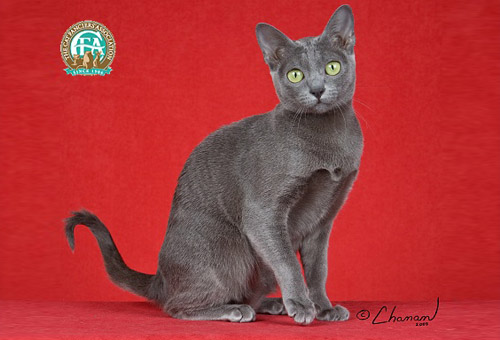


| Korats have extraordinary powers of hearing, sight and scent. They are gentle pets, moving softly and cautiously, disliking sudden, loud or harsh noises. Those destined to be shown must be trained from birth to accept noise and handling, possibly by keeping a radio on in the nursery, and by lifting and posing the kitten as judges do. Korats form an exceptionally strong bond of affection with their owners and respond warmly to cuddling, setting as close as possible. They mix well with other cats but tend to want to have the upper hand and will not let the others keep them from their rightful place at their owner’s side. They have been cherished for centuries in their native Thailand and they naturally expect this tradition to be maintained wherever they go. Korats are active in their play, but are very gentle with children.  Pictured: Second Best of Breed GC KIRIKI TULAYA, Korat Female Photo: © Chanan Their hair does not float off when they are being stroked and petted, so many people with an allergy to cat hair find their proximity tolerable. The roots of the hair are a light bluish color, darkening before the ends become silver-tipped. This silvering over the whole body should make a halo, or aura, effect and the close lying fur shines like a polished silver dollar. They are considered a symbol of good fortune by the Thais. Many good luck traditions surround the Korat: they are the color of silver, signifying wealth; they are the color of rain clouds, with eyes the color of young rice, meaning good crops. The gift of a pair of Si-Sawat cats to the bride ensures a fortunate marriage. The earliest known picture of a Korat, or Si-Sawat, cat is to be found in the ancient book of paintings and verses known as The Cat-Book Poems in Bangkok’s National Library. It is believed by the Fine Arts Department, a division of Thailand’s Ministry of Education, to have been produced some time during the Ayudhya Period of Siamese History (1350-1767).
A high-ranking monk, Somdej Phra Buddhacharn Buddhasarmahathera, was commissioned by King Rama V (1869-1910) to copy The Cat-Book Poems on special Khoi paper. Known as the Smud Khoi of Cats, it hangs in a high glass case in the Minor Arts Room of Bangkok’s National Museum. Books were folded, not bound as is a more recent version, known as The Book of the Cat, also in the National Museum, which is apparently a twentieth century version of the cats and their accompanying verses. This shows seventeen cats, whose ownership brings good fortune and six with boding of the very reverse. Among the Good Luck cats is the Korat. King Rama V is said to have named the breed when he remarked, “What a pretty cat - where is it from?” and was told “Korat.” Presently in Thailand the Korats are generally referred to as the Si-Sawat cats (see-sah-waht) and are found in other provinces as well. There’s no changing the color of the breed. Korats are silver-blue from their first day until their last; a cat of any other color is not a Korat. Their coats are soft and close-lying, with each blue hair tipped with silver. In 1959, the first known pair of Korats (Nara and Darra), were imported into the United States. The Korats were accepted for competition in CFA in the championship category in 1966. Pricing on Korats usually depends on type, applicable markings and bloodlines distinguished by Grand Champion (GC), National Regional winning parentage (NW or RW) or of Distinguished Merit parentage (DM). The DM title is achieved by the dam (mother) having produced five CFA grand champion/premier (alter) or DM offspring, or sire (father) having produced fifteen CFA grand champion/premier or DM offspring. Usually breeders make kittens available between twelve and sixteen weeks of age. After twelve weeks, kittens have had their basic inoculations and developed the physical and social stability needed for a new environment, showing, or being transported by air. Keeping such a rare treasure indoors, neutering or spaying and providing acceptable surfaces (e.g. scratching posts) for the natural behavior of scratching (CFA disapproves of declawing or tendonectomy surgery) are essential elements for maintaining a healthy, long and joyful life. There are CFA clubs devoted to the promotion, protection and preservation of the Korat breed. For more information, please send inquiries to CFA at cfa@cfa.org. Text: In part with permission from "The Korat Story" by Daphne Negus Last Updated: Sunday, July 04, 2010
|